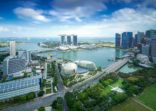Barings has launched in Hong Kong, Korea and Taiwan the Barings Global High Yield Bond Fund and the Barings Global Senior Secured Bond Fund.
Both funds focus on the US and European markets, Martin Horne, head of global high yield investment group, said at a media briefing in Hong Kong this week.
Discussing the global high yield bond fund, Horne believes that long-term, returns of high yield bonds are comparable to equities, with lower volatility. Although investors can potentially get higher returns from equities, the drawdowns in high yield bonds are significantly lower.
On a three-year annualised basis, returns of the S&P 500 and MSCI AC World indices are higher compared to both the Bloomberg Barclays Global High Yield and US Corporate High Yield indices, according to data from FE Analytics.
Three-year annualised measures
| Return | Volatility | Sharpe | |
| Bloomberg Barclays Global High Yield TR in US |
8.31 |
4.39 |
1.09 |
| Bloomberg Barclays US Corporate High Yield TR in US |
9.38 |
4.72 |
1.25 |
| Index : MSCI AC World GTR in US |
11.9 |
11.68 |
0.72 |
| S&P 500 GTR in US |
13.65 |
12.69 |
0.8 |
Source: FE Analytics
The high yield indices have significantly lower volatility and higher Sharpe ratios, which mean investors are getting better risk-adjusted returns on the asset class.
Horne added that the default rates for high yield in both the US and Europe are low, at 2.7% and 1.6%, respectively.
However, there is a big risk with high yield, also known as junk bonds. Rising interest rates make servicing debt more expensive for corporations, and higher rates could spark more defaults.
Senior and secured high yield
Turning to the senior secured bond fund, Horne explained that the product invests mainly in senior and secured high yield bonds.
Senior and secured high yield bonds are sub-investment grade or unrated debt securities, according to Horne. However, given that they are “secured at a senior level”, bondholders are positioned higher in the event a company goes through a restructuring process.
These bonds are also backed by collateral, which means it has a higher recovery rate of principal invested relative to unsecured high yield bonds.
Horne noted that the product may be attractive for investors who are bearish on the economy.
“If you are facing a severe economic event, BB-rated bonds become single Bs quickly. I prefer to be in a single B secured piece of paper than a BB unsecured bond if you are suffering a hard economic event,” he said.
Fixed income sentiment
The launch of both funds comes at a time when investor sentiment in Asia is mixed toward fixed income funds.
In Taiwan, fixed income funds have become very popular. Last year, the asset class accounted for 28% of the country’s onshore fund industry, compared to just 17% the previous year, according to Morningstar data.
Fixed income funds were also in demand last year in China, with net inflows of RMB 399.1bn ($58.94bn) compared to RMB 145.1bn of net inflows in the previous year, according to a Morningstar report.
The opposite is seen in other markets, however. Fixed income funds were largely avoided in Hong Kong. During the first 10 months last year, fixed income funds in the SAR saw the largest net outflows at around $6.1bn, according to data from the Hong Kong Investment Funds Association.
Bond funds were also avoided in Singapore, with net outflows of S$348.7m ($257.14m), according to the Morningstar report.
Thai investors also fled from the asset class, particularly from global bond funds, which saw the largest outflows in the country at around $3.1bn, according to a Morningstar report.

















